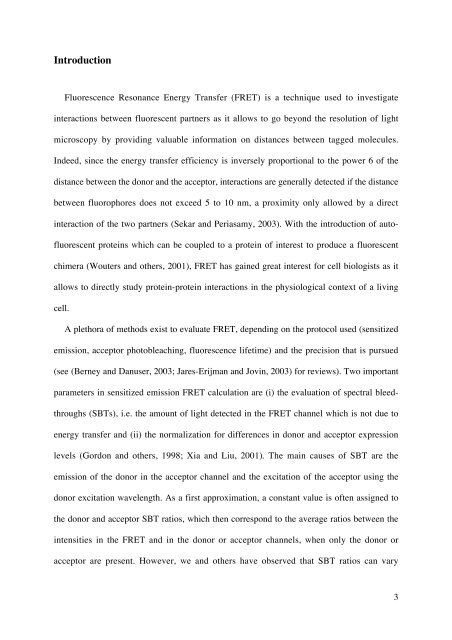PixFRET, an ImageJ plug-in for FRET calculation which can ...
PixFRET, an ImageJ plug-in for FRET calculation which can ...
PixFRET, an ImageJ plug-in for FRET calculation which can ...
- No tags were found...
You also want an ePaper? Increase the reach of your titles
YUMPU automatically turns print PDFs into web optimized ePapers that Google loves.
IntroductionFluorescence Reson<strong>an</strong>ce Energy Tr<strong>an</strong>sfer (<strong>FRET</strong>) is a technique used to <strong>in</strong>vestigate<strong>in</strong>teractions between fluorescent partners as it allows to go beyond the resolution of lightmicroscopy by provid<strong>in</strong>g valuable <strong>in</strong><strong>for</strong>mation on dist<strong>an</strong>ces between tagged molecules.Indeed, s<strong>in</strong>ce the energy tr<strong>an</strong>sfer efficiency is <strong>in</strong>versely proportional to the power 6 of thedist<strong>an</strong>ce between the donor <strong>an</strong>d the acceptor, <strong>in</strong>teractions are generally detected if the dist<strong>an</strong>cebetween fluorophores does not exceed 5 to 10 nm, a proximity only allowed by a direct<strong>in</strong>teraction of the two partners (Sekar <strong>an</strong>d Periasamy, 2003). With the <strong>in</strong>troduction of autofluorescentprote<strong>in</strong>s <strong>which</strong> c<strong>an</strong> be coupled to a prote<strong>in</strong> of <strong>in</strong>terest to produce a fluorescentchimera (Wouters <strong>an</strong>d others, 2001), <strong>FRET</strong> has ga<strong>in</strong>ed great <strong>in</strong>terest <strong>for</strong> cell biologists as itallows to directly study prote<strong>in</strong>-prote<strong>in</strong> <strong>in</strong>teractions <strong>in</strong> the physiological context of a liv<strong>in</strong>gcell.A plethora of methods exist to evaluate <strong>FRET</strong>, depend<strong>in</strong>g on the protocol used (sensitizedemission, acceptor photobleach<strong>in</strong>g, fluorescence lifetime) <strong>an</strong>d the precision that is pursued(see (Berney <strong>an</strong>d D<strong>an</strong>user, 2003; Jares-Erijm<strong>an</strong> <strong>an</strong>d Jov<strong>in</strong>, 2003) <strong>for</strong> reviews). Two import<strong>an</strong>tparameters <strong>in</strong> sensitized emission <strong>FRET</strong> <strong>calculation</strong> are (i) the evaluation of spectral bleedthroughs(SBTs), i.e. the amount of light detected <strong>in</strong> the <strong>FRET</strong> ch<strong>an</strong>nel <strong>which</strong> is not due toenergy tr<strong>an</strong>sfer <strong>an</strong>d (ii) the normalization <strong>for</strong> differences <strong>in</strong> donor <strong>an</strong>d acceptor expressionlevels (Gordon <strong>an</strong>d others, 1998; Xia <strong>an</strong>d Liu, 2001). The ma<strong>in</strong> causes of SBT are theemission of the donor <strong>in</strong> the acceptor ch<strong>an</strong>nel <strong>an</strong>d the excitation of the acceptor us<strong>in</strong>g thedonor excitation wavelength. As a first approximation, a const<strong>an</strong>t value is often assigned tothe donor <strong>an</strong>d acceptor SBT ratios, <strong>which</strong> then correspond to the average ratios between the<strong>in</strong>tensities <strong>in</strong> the <strong>FRET</strong> <strong>an</strong>d <strong>in</strong> the donor or acceptor ch<strong>an</strong>nels, when only the donor oracceptor are present. However, we <strong>an</strong>d others have observed that SBT ratios c<strong>an</strong> vary3
















